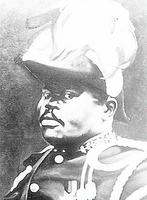
The remains of the body of Marcus Garvey were brought back to Jamaica in 1964 and re-interred in the King George VI Memorial Park in Kingston. Later, he was named Jamaica's first National Hero, and the site of his reburial was renamed National Heroes Park.
Garvey's dream in his short lifetime was to unite "all the Negro peoples of the world into one great body to establish a country and government exclusively their own". He formed the Universal Negro Improvement Association with the motto: 'One God! One Aim! One Destiny!', and with branches in the Caribbean, North, Central and South America and Africa.
His writings and philosophy have inspired many African leaders and many of Jamaica's singers, painters and poets.
1. 1964: Members of the Federation of Commonwealth Chambers of Commerce who arrived as part of a tour following the 22nd Congress of the Federation held in Port of Spain, Trinidad. They were met by representatives of the Jamaican Chamber of Commerce and the Jamaican Manufacturers' Association (JMA), including Mr. Laurie Ramson (left), chairman of the chamber, and Ray Hadeed (beside him), second vice-president of the JMA.
2. 1964: Dwarfed by the machinery, guests at the official opening of the Esso Oil Refinery tour the premises.
3. 1963: Amy Garvey, widow of the late Marcus Garvey, at the base of his statue.
4. Marcus Mosiah Garvey, in his newspaper 'The Black Man', recorded the struggle of the unemployed before the 1938 labour riots.

